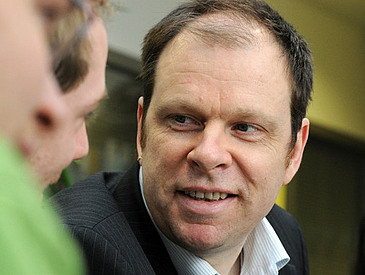The European Research Council approved a three million grant to the geochemist Prof. Kai-Uwe Hinrichs. In the following five years, Hinrichs and his work group want to use this money to realize the ZOOMECULAR project. This project wants to track climate and environmental processes throught Earth’s recent history at unprecedented resolutions using molecular imaging techniques applied to geological samples. Within the framework of the prestigious funding line Excellent Science, the Research Council awards a total of 445 million Euros to 190 scientists across Europe. This line of funding is part of the EU Research Framework Plan Horizon 2020.
A publication that appeared in the distinguished US scientific journal PNAS in 2014 provided the impetus for a proposal that has now been selected for funding by the European Research Council. At that time Hinrichs and his group had extracted environmental information from about 10,000 year old sediments of the Mediterranean Sea with a temporal resolution of four years. Until then, such high resolution had been inconceivable in these types of sedimentary deposits. The investigations, made possible by the coupling of a special laser with a mass spectrometer, focus on organic molecules called lipid biomarkers. These are the building blocks of unicellular marine organisms that lived, and still live, in all the world’s oceans. Lipids deposited in the sediments by these dead single-celled organisms provide proxy information about ancient environmental conditions in the sea.
“Through the ZOOMECULAR project we can now continue and advance this complex research,” says Kai-Uwe Hinrichs. “With these novel methods we are practically able to zoom our molecular analyses to tiny sediment spots a tenth of a millimeter in size in order to reconstruct and better understand complex climate processes in Earth’s recent history on an annual scale.” The molecular trip through time will provide new knowledge of highly dynamic climate processes. Examples include the Little Ice Age near the close of the Middle Ages, an abrupt cool period at the end of the last ice age known as the Younger Dryas, and the fluctuations between El Nino and La Nina in the Pacific. As a geochemist, however, Hinrichs also wants to learn more about how unicellular organisms behave in the sediment and the roles they ultimately play within global element cycles.
The person Kai-Uwe Hinrichs
Hinrichs, a professor of organic geochemistry at the University of Bremen since 2002, is one of only seven Earth scientists who were successful in the Excellence funding round of the European Research Council, and one of very few researchers who has achieved it twice. He already received an ERC award in 2010. “Considering the intense competition for funds from the ERC this is an exceptional achievement,” says MARUM director Prof. Michael Schulz. “It also illustrates once again that the conditions at MARUM and the University of Bremen make this kind of world-class research possible.”

